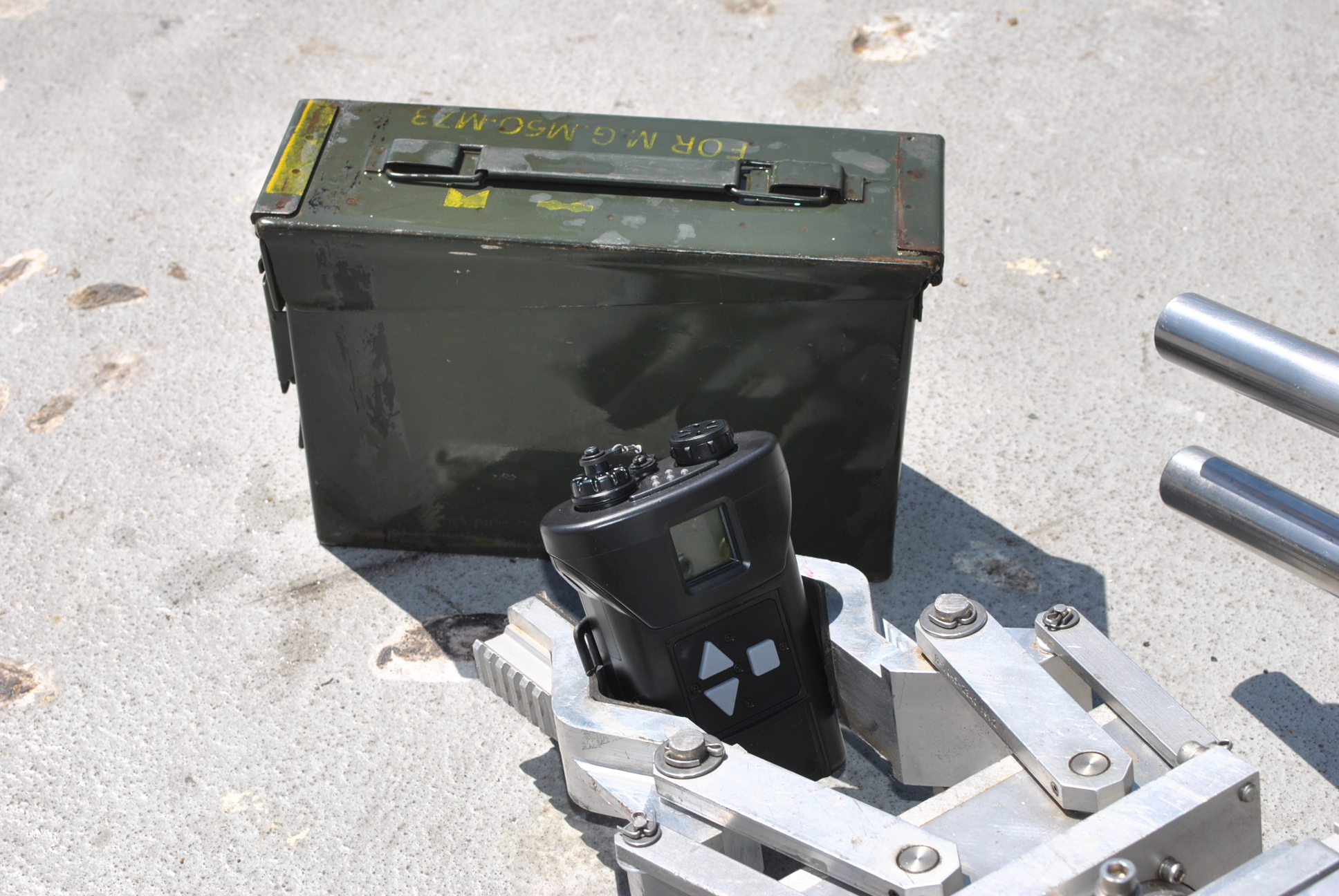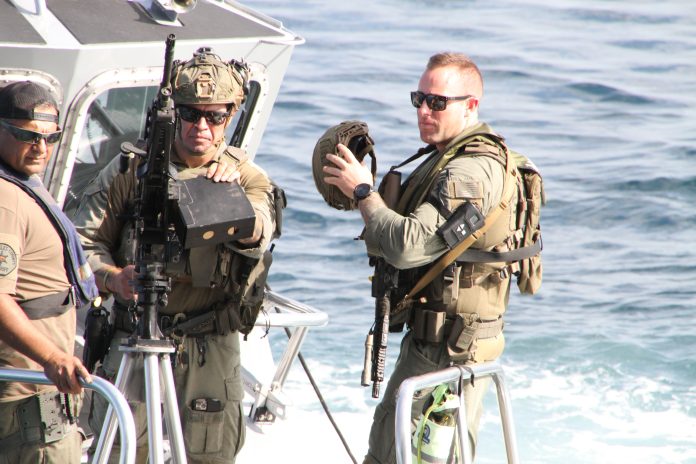Originally published ThreatShield Shines at Coastal Trident 2024 – Demonstrates Importance of Chemical Detection for Military and Law Enforcement on by https://modernbattlespace.com/2024/11/21/threatshield-shines-at-coastal-trident-2024/ at Modern Battlespace
As we discussed in a previous article on The Modern Battlespace, there are numerous unseen threats that law enforcement and emergency response personnel face in their daily activities and operations. Whether they’re responding to chemical spills or arriving at a crime scene with unknown substances, these operators need the ability to detect Chemical, Biological, Explosive, Radiological, and Nuclear (CBERN) threats in their environment for their safety and the safety of civilians.
Considering the sheer number of unseen threats these operators face, a mobile, wearable CBERN detection solution has become a requirement, not just a “nice to have.” Thanks in large part to military investments, incredible advancements have been made in the development of mobile chemical agent detection devices.
These new solutions, including the Collins Aerospace ThreatShield-mini™ solution – are capable of alerting wearers to the presence of a number of chemicals, including commonly encountered industrial chemicals such as ammonia, chlorine, and sulfur dioxide. These devices, which are small and light enough to be attached to an operator’s body armor or uniform, give the wearer an audible alarm or vibration – alerting them to threats in the area even if their attention is on the primary mission at hand.
…it’s incredibly important to ensure that each individual operator has a body-worn chemical agent detection solution for their own safety…
However, while recent events have demonstrated the importance of CBERN detection for law enforcement personnel, emergency responders, and other operators, these same individuals can often be reticent to carry additional equipment. Any new solution that these operators carry—even those as essential as chemical agent detection—needs to be lightweight, easy to use, and not interfere with the mission.
This is why Collins Aerospace was excited to demonstrate its ThreatShield-mini solution to the Advanced Naval Technology Exercise (ANTX) Coastal Trident 2024 (CT24) program.
Simulated CBRN for multiple types of operators
The ANTX-Coastal Trident program is an annual training and exercise program conducted at the Port of Hueneme. These training exercises bring together operators from various agencies across the U.S. Department of Defense, federal law enforcement, state and local law enforcement, and other government agencies and provide an opportunity to train and prepare for a wide array of situations and incidents that may be encountered both at sea and on land.
The exercises also include industry partners and technology solution providers, which train operators on new systems and capabilities and demonstrate exciting new innovations for government decision-makers.
According to Brendan Applegate, the Lead for Fleet Experimentation and Exercises at the NSWC Port Hueneme Office of Technology, the inclusion of industry partners delivers “…unique training and exercise opportunities, awareness and access to leading-edge technologies, collaborative public and private sector engagement, and valuable knowledge to enable informed decisions about addressing operational limitations through technology.”
…the ThreatShield-mini device can be quickly and easily deployed to operators…[Who] can carry it with them on their missions without compromising their movement or ability to operate.
As part of the ANTX-CT24 activities, Collins Aerospace equipped operators from defense, law enforcement, and emergency response organizations with its ThreatShield-mini wearable chemical agent detection solution. The results—and lessons learned—were excellent.
During the ANTX-CT24, Collins participated in two events. The first was a simulated vehicle that had plunged into the harbor. While rescue divers inspected the vehicle, a local law enforcement explosive ordnance disposal (EOD) team and Collins Aerospace prepared to assist. Eventually a suspicious canister with unknown contents was retrieved and carefully moved to a secure position on shore.
The EOD robot, equipped with a ThreatShield-mini device was called in to inspect the contents of the canister. The integration of ThreatShield-mini with an autonomous vehicle helped keep both operators and bystanders safe as the situation developed and became better understood. Thanks to the Ventura County Sheriff’s Department and ThreatShield-mini, the suspicious canister was deemed to be no threat and was disposed of properly.

In the second exercise, Sheriff’s deputies were equipped with the ThreatShield device for a simulated hostage scenario following the hostile take-over of a real-life gas/oil platform off the coast of Los Angeles. After the call was put out that a platform was overtaken, Sheriff’s deputies equipped with ThreatShield-mini devices launched on an eight-mile insertion via rigid boats.
Once on scene, the operators quickly assaulted the platform, cleared vital areas and were able to secure the objective and neutralize the hostile force all the while knowing their teams were safe from unknown toxic industrial chemicals or other unseen agents. Since it was impossible to safely expose participants to chemical agents, the ThreatShield-mini device was outfitted with a training application able to be triggered remotely via mobile device, enabling the operators to react to a simulated agent.
Operators reported that the ThreatShield-mini device was small and easily wearable. However, some adjustments could be made to connect the device to operators in a more optimal and convenient position. Regardless, all who learned about ThreatShield-mini were impressed by its small form factor and ease of use.
…while recent events have demonstrated the importance of CBERN detection for law enforcement personnel, emergency responders, and other operators, these same individuals can often be reticent to carry additional equipment.
But the most exciting lessons learned from Coastal Trident involved other use cases and applications of the technology that the Collins team hadn’t considered.
Up high and down below
While it’s incredibly important to ensure that each individual operator has a body-worn chemical agent detection solution for their own safety, there are other ways this technology could be deployed that would benefit operators and even civilians.
For example, during the Coastal Trident Event, the Collins team asked if ThreatShield-mini devices could be mounted to drones or other autonomous vehicles to identify chemical agents in an area without putting humans at risk. We were incredibly excited about standoff detection because it could help save lives and keep operators from becoming contaminated by charging into an area where they don’t know what they’re breathing or what invisible threats they may be facing.
Unfortunately, we were unable to conduct an airborne test at this year’s Coastal Trident due to drone maintenance issues and unavailability. Stay tuned, however. Collins does plan to conduct some internal tests and demonstrate standoff detections during next year’s exercise.
Any new solution that these operators carry—even those as essential as chemical agent detection—needs to be lightweight, easy to use, and not interfere with the mission.
Additionally, through follow on discussions with potential customers, Collins plans to demonstrate ThreatShield-mini’s application in enclosed spaces such as underground shelters or storage facilities – a use case that clearly has real world applications today and into the future.
While there are certainly more capabilities to showcase in the future, there were still many useful lessons learned during ANTX-CT24.
We confirmed that the ThreatShield-mini device can be quickly and easily deployed to operators and that they can carry it with them on their missions without compromising their movement or ability to operate. We validated the need for chemical agent detection among law enforcement, military, and emergency response operators. And, finally, we came away with some exciting new case cases for the technology we’re eagerly developing and evaluating.
We’d like to thank the U.S. Navy, Naval Surface Warfare Center, the Ventura County Sheriff’s Department, and the entire Port Hueneme community for the opportunity to showcase ThreatShield-mini. We are already looking forward to ANTX-CT25.
Originally published ThreatShield Shines at Coastal Trident 2024 – Demonstrates Importance of Chemical Detection for Military and Law Enforcement on by https://modernbattlespace.com/2024/11/21/threatshield-shines-at-coastal-trident-2024/ at Modern Battlespace
Originally published Modern Battlespace


